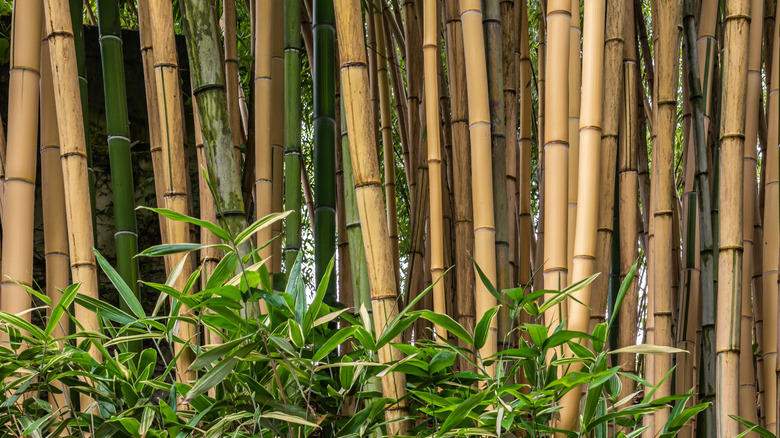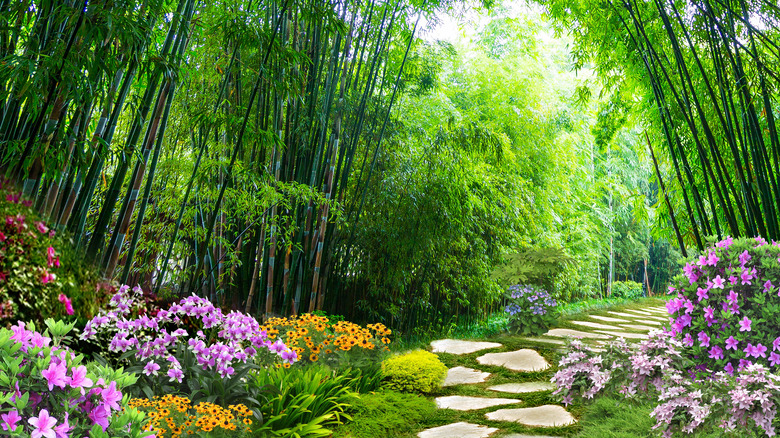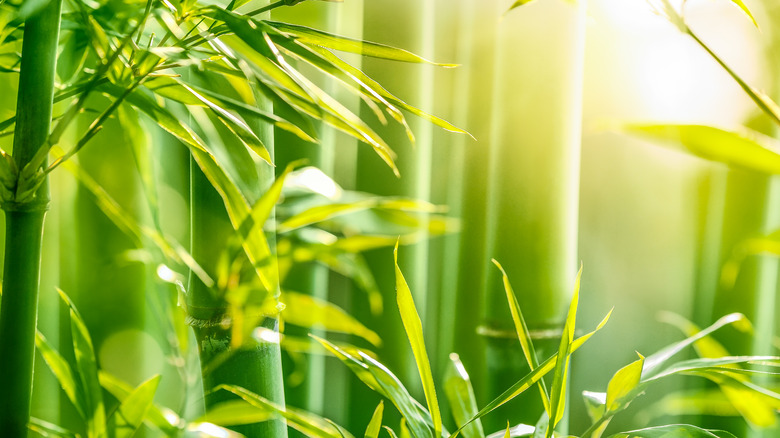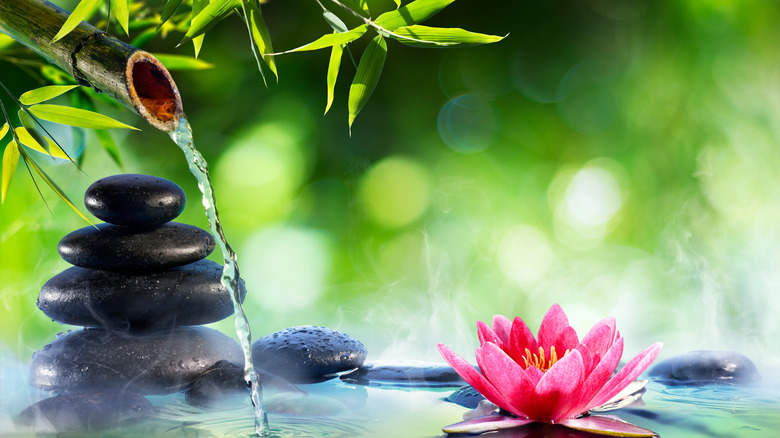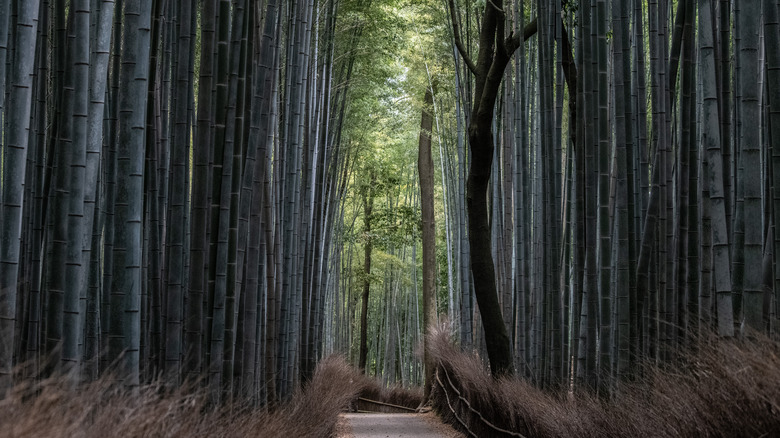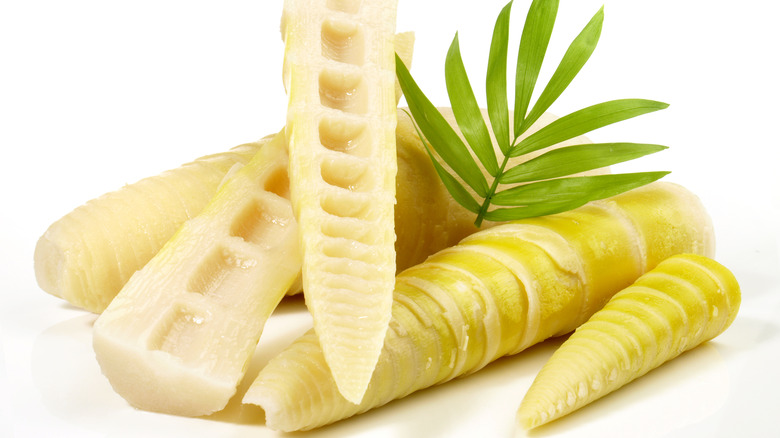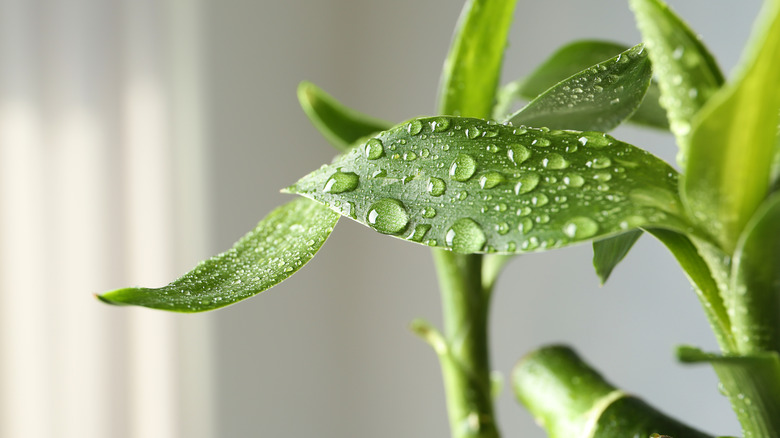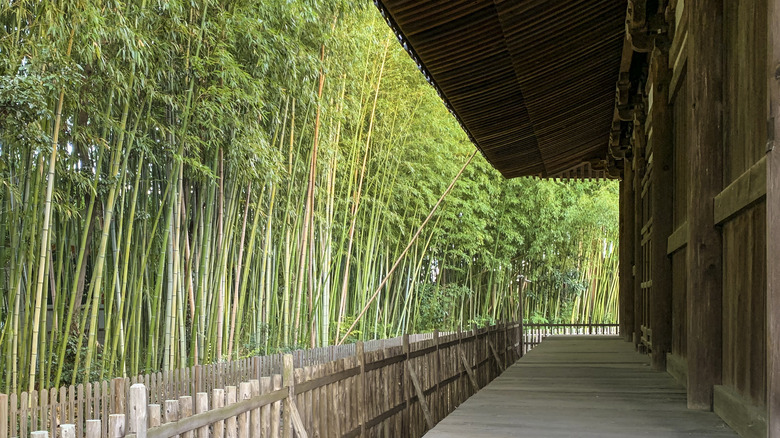How To Grow And Take Care Of Bamboo Plants
Elegant and serene, bamboo (Bambusoideae) is an ancient perennial plant cherished for its reputation for offering good fortune, strength, and prosperity to anyone who owns it. Often revered for its sturdiness and fortitude, bamboo is not a tree but a grass within the Poaceae family. According to China Daily, bamboo is extremely versatile, as humans have utilized it on so many levels for thousands of years. Its sturdy, composite stem (or culm) is frequently used to construct buildings, houses, scaffolding, and vessels. It also grows rapidly, which is why there is so much of it! Bamboo itself is a general term for several perennial grass types with hollow, wood-like stems called culms (via Bamboo Botanicals). Most bamboo leaves are evergreen in color, with some showing white, cream, yellow, or blue shades.
While bamboo is found in several continents around the globe, its origin is believed to have come from China, as the country holds the greatest number of bamboo species. Ancient Chinese people quickly discovered how bamboo could be used in their everyday lives. From food to paper, it's known as the number one renewable resource. If you're considering planting bamboo, there's plenty to know about this vivacious plant before you begin. Keep reading to learn more!
How to use bamboo in the garden
In all honesty, bamboos are an aggressive, invasive plant. They prefer to be planted in the ground, and they thrive in warm, tropical climates. A hungry, durable grass, they'll breed under most conditions if they receive enough water and sun each day. There are two types of bamboos to consider: Running and clumping. Better Homes and Gardens suggests choosing a clumping type of bamboo plant if you want to control its thriving growth pattern. They may conquer the yard as they develop, inhibiting other plants from flourishing in your garden.
Placing it in the east corner is ideal if you believe in the prosperous aspects of bamboo (via Architectural Digest). Consider planting tall clumping bamboos like weavers (Bambusa textilis var. gracilis) if you want shade or privacy. Clumping bamboo expands steadily as it grows and requires partial shade. The stems are a great choice for shaping. Also, be aware of where you plant your bamboo and if you have neighbors nearby that might be affected by any intrusive growth. Wherever you decide to plant outside, make sure the soil provides good drainage, and there's plenty of sunshine. They will grow faster in full sun.
How to grow bamboo plants
When it comes to growing bamboo, it's important to decide which kind of bamboo will suit your yard: A clumper or a runner? Running bamboos are the most invasive ones. You can plant them in a controlled environment by using a container or building a barrier by digging a trench line. Better Homes and Gardens suggests a depth of 30 inches around the perimeter of the area. This is the best way to regulate their initial growth and thwart rhizomes from protruding out (via The Spruce).
Where should you plant bamboo? In the ground is its best natural habitat. Place it away from the house and pool to avoid leaf cleanup. Bamboo is nitrogen hungry, so Greg the Gardener recommends planting bamboo in rich compost like mushroom compost or clay soil. Dig a hole that is twice the size of the plant and place it approximately 1 inch deeper than the pot it came in. Spread the roots, fill the hole back with soil, and water it before inserting it into the ground. Greg also notes that spring is the best time to plant your bamboo to give it a good launch. Water it well the first few weeks. To retain the moisture, incorporate a 2 to 3-inch layer of compost, mulch, grass trimmings, leaves, or hay on top.
How to care for your bamboo plants
Bamboo is largely low maintenance and agrees with most soils. Keep its water intake balanced. If it looks dry, water it. Once your bamboo is officially planted, give it a good drink of water every two days. From there, if the foliage starts to look brown and wilted, then it's not getting enough water. If it starts losing a substantial number of leaves, that's another indicator that the soil is either too wet or too dry. Overall, it can rely on rainfall as well. According to Pennington, too much watering could cause root rot, which indicates that the roots are decaying. This can't be reversed.
Apartment Therapy notes that bamboo can have a sensitivity to chemicals, including salts found in tap water. If you're using tap water for watering or misting your indoor bamboo, leave it out overnight to allow the chlorine to fade. Bamboo doesn't often require fertilizer, but feed it with high nitrogen fertilizer if you think your plant could use a boost (via SF Gate). This will keep it green and happy. You could also use compost, organic plant food, or non-weed-killing lawn fertilizer. With compost, scatter a 1 to 2-inch layer around the plant in the spring. If you prefer, add plentiful amounts of plant food and lawn fertilizer in the spring and summer months.
Bamboo plant varieties
The amount of bamboo varieties is just as great as the growth of this soaring plant. According to Bamboo Botanicals, there are over 1400 varieties and counting. The goliath grass is often found in tropical, subtropical, and temperate regions like Southeast Asia, South America, and Southeastern sections of the United States. Depending on the type, its height varies. It grows 15 to 30 feet on average, but tall timber bamboo can reach up to 50 feet or more.
Bamboo has three distinctive ancestors: Bambuseae (tropical), Arundinarieae (temperate), and Olyreae (herbaceous). Here are some prevalent bamboo plants within this group:
- Chinese dwarf (Bambusa multiplex): This friendly bamboo plant is soft and bushy in appearance and can be used in pots and troughs but is perfect for hedges.
- Giant tinder bamboo (Bambusa oldhamii): This is the largest bamboo species and is most commonly grown in North America. This graceful giant grows up to 65 feet in height.
- Golden bamboo (Phyllostachys aurea): This is an invasive bamboo plant commonly found in the United States. Often used as an ornate garden plant, it can grow up to 40 feet. It may overpower your garden and is challenging to remove.
- Slender weavers (Bambusa textilis): A wonderful non-invasive, clumping bamboo. It is mainly used as a privacy screen.
- Lucky bamboo (Dracaena sanderiana): Often placed at home or in the office, it's important to note that lucky bamboo is not really bamboo (via The Spruce). It's a succulent.
Is bamboo toxic?
Can you eat bamboo? Yes and no. Raw bamboo contains cyanide and can make anyone seriously ill, especially if consumed in large portions. However, the bamboo shoot part of the plant is edible. These new culms sprout up each spring and are located at the tip of the bamboo. Make sure they come from a mature bamboo plant (via Gardening Know How). Bamboo shoots are used as a vegetable in various Asian dishes and other cuisines. They are a nutritious addition to any diet and a good source of fiber and potassium. It is also safe to eat canned shoots. Make sure to rinse them before consuming.
While most Bambusoideae species of bamboo are considered safe for pets, it's still smart to be cautious. According to At Home with Hues, the leaves have a mild toxicity level, which can cause health problems if digested. And even though lucky bamboo is not a bamboo plant, it is dangerous for pets to be around, as it is considered toxic. Decide on the best location for your bamboo plant (indoors and outdoors) in relation to your pets to avoid unwanted situations.
How to repot bamboo plants
Running and clumping bamboos are both easy to plant in pots and containers. When potted, running bamboo is a great plant to enhance your privacy on a terrace or patio. They will grow fast and high, so be prepared to transition them when they look root bound within the soil. Clumping bamboo is generally shorter and fluffier and will last longer in its starter pot. Depending on the type of bamboo you have and its pot size, SF Gate suggests dividing and repotting it every three to five years. If you're going to take on the task of potting and repotting your bamboo plant, it's simple, but start with the proper provisions.
You will need newspaper or sheeting, clippers, a low and wide rectangular pot, potting soil, compost, and mulch. Start by removing any excess dirt from the bottom of the bamboo plant's roots. If dividing them, make sure to include roots and at least three culms. Cut them individually and carefully with your clippers. Next, fill 1/3 of your pot with potting soil. This concoction includes 3 parts potting soil to 1 part compost. Once you place the plant in the pot, fill it lightly with soil and pat gently. Do not pack it down too tight.
When to prune your bamboo
Is your bamboo ready for a trim? Considering how fast the lush grass likes to grow, some pruning should help minimize overgrowth, as per Lewis Bamboo. Once a year in late summer or fall is enough. Trimming it too much will bring on more shoots quicker. Also, your bamboo plant should be well established before its first pruning. Start in its third to fifth season. For a topiary look, you can chop the upper portion of the plant, but be aware that it won't continue to grow vertically. Unlike trees, bamboo does not have a second growth. It will spread out more horizontally.
When pruning indoor bamboo plants, use very sharp shears to cut back any unwanted shoots (or stems) at least 1 to 2 inches in length. For your towering outdoor bamboo, cut off the weepy culms and branches as needed (via Wilson Bros Gardens). As planting bamboo is often controversial, there is no doubt that its aggressive nature is indeed a symbol of its strength. Whichever bamboo you decide to plant, your garden or business will surely benefit from its aesthetic grace.
